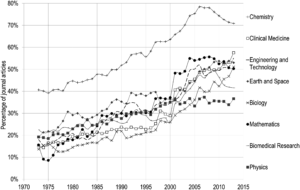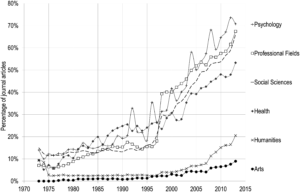1.3 The Economics of Publishing
As of 2015, the academic publishing ecosystem is a 25 billion dollar a year industry. In addition to being a large industry it is a consolidated one, with only 5 for-profit publishers responsible for approximately 50 percent of all output.
Test your knowledge
The consolidation of publishing varies across disciplines, reaching an upper limit of around 70% in areas such as Psychology and Chemistry.

Percentage of papers published by the five major publishers, by discipline in the Natural and Medical Sciences, 1973–2013. Retrieved from Larivière et al. (2015). The Oligopoly of Academic Publishers in the Digital Era.

Percentage of papers published by the five major publishers, by discipline in the Social Sciences and Humanities, 1973–2013. Retrieved from Larivière et al. (2015). The Oligopoly of Academic Publishers in the Digital Era.
Unsurprisingly, a lack of competition among publishers has had a significant impact on the price of scholarship. Decades of subscription cost increases and talk of 40 percent profit margins for the biggest names in academic publishing, have been concerns for academic libraries for years. Unfortunately, unsustainable pricing is an issue that has not garnered as much attention with the larger academy. This is perhaps due to the peculiarity of the economics of scholarly publishing whereby the main consumers of academic research (academics and students) are largely shielded from the cost.
Aside from purely financial considerations, consolidation and commercialization have the potential to cause harm to the integrity of science itself. Increasingly, publishers favor positive results and novel studies. Researchers, realizing what is likely to get published, may then direct their research in order to meet these demands. In recent years scientists have begun to reckon with the consequences of publication bias, including bringing awareness to the replication crisis and advocating for high impact journals to highlight negative results studies.
Dig Deeper
To learn more about consolidation in academic publishing, review:
Larivière et al. (2015). The Oligopoly of Academic Publishers in the Digital Era. Licensed under CC-BY.
Publishers as research analytics providers
At the same time that big publishers have been creating new journals and purchasing smaller publishers and independent journals, they have also expanded their portfolios to include products and services relevant to other parts of the research life cycle. For example, along with its scholarly publications Elsevier is also the owner of Scopus, SciVal, Pure, Clinicalkey, Mendeley, SSRN, and several other tools that researchers, librarians, and institutions rely on to support the research endeavor.
As these publisher brands continue to expand and integrate other pieces of academic infrastructure into their portfolios, there is growing concern about the implications this will have on the academy. While it may be feasible for scholars and institutions to publish their own journals and make their research available, it is much harder to imagine them recreating tools like SciVal, which pulls data from other Elsevier products to visualize research performance and benchmark scholars relative to their peers. It is perhaps telling then that in recent years Elsevier has rebranded itself as a “global information analytics business”, choosing to highlight its value not in publishing but in analytics tools, which are supported using data generated via its publishing arm.
Case Study – Bepress
In late 2017 Elsevier announced their acquisition of Bepress, a scholar-led company responsible for Digital Commons – a cloud-based institutional repository software that allows universities to share research outputs such as preprints, student theses, data sets and special collections with the public for free. The sale to Elsevier, long considered an adversary to many in academic libraries, prompted sharp rebukes from Bepress customers, spurring some to call for a “beprexit”.
Should libraries and academic communities be concerned with consolidation within the researcher infrastructure marketplace? What are the advantages and disadvantages to consolidation?
Should there be an expectation that scholar-led or community supported endeavours remain non-profit?
Dig Deeper
To learn more about the consolidation of academic infrastructure, review:
Posada, Alejandro and George Chen (2018). Inequality in Knowledge Production: The Integration of Academic Infrastructure by Big Publishers. Licensed under CC-BY.
